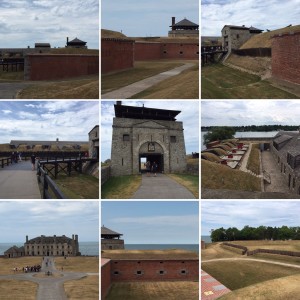This is an extremely sensitive topic for me, because the focus of my research (masonry fortifications dating from the colonial period) are something that serve no purpose today. Clem Levine was quoted as saying that preservation was un-American because “America was built on the concept of the frontier. Land was limitless. Resources were never ending. The pioneer way was to use it up, throw it away and move west”(12). This seems to be even worse out here in the West. That list of endangered places in Boise, Lewiston, and Minidoka was heart breaking.
The part of this reading that I found the most thought provoking concerned the different preservation philosophies. A close reading of the ideas of Viollet-de-Duc and Ruskin’s ideas shows problems with both ideas. For one, I like the idea of restoration. I’ve been to “Colonial Williamsburg” and I liked it. That being said, I don’t think it is a model that should be followed everywhere. On the other hand, I can see why Ruskin, writing in the 19th century thought that ruins were “romantic” and “sublime.” It’s how people thought back then, but if nothing’s done about them, ruins tend to stay ruins. And said ruins, by their ruinous nature, are dangerous. And to be fair, some ruins are beautiful and sublime, like mountain ghost towns, or Fort Stevens on the Oregon coast. But it is prohibitively expensive to repair, renovate, restore, or even stabilize some of these sites.
Personally the hardest part of this reading was the portion about urban renewal and historic districts. Urban renewal has a place. When I was younger my father used to call downtown Boise “downtown Beruit” because of how sketchy it was. Then they opened the 8th Street Market place, and I would challenge anyone to compare Boise to Beruit now. And I think Boise did a good job mixing façadomy with new construction, but I think some of the neighboring communities (mostly Nampa) in trying to follow Boise’s lead fell short of the mark.
This talk of Nampa leads to the title of this post. Nampa had a beautiful old city hall. They tore it down and put a fountain where it was. That fountain has since been torn out and there is a library very nearly on the spot of the old city hall. The city hall is very nearly the same size as the library building which begs the question, why not have just used the old building? The answer, it costs less to knock it down than it does to keep it up.
I’m including this collage form my trip to old Fort Niagra because it represents a good compromise between the two discussed preservational styles. I hope you enjoy.


I also struggle with the idea that sites that are not ‘useful’ should not be preserved, as I am a medievalist and its hard to argue for castles being ‘useful.’ I think you are correct in your assessment that it is often less expensive to demolish a site than attempt to maintain it, particularly in an era of stinginess on the government budgets regarding grants and maintenance assistance. It’s hard to balance the intrinsic value of a piece of our historic pasts with the harsh reality that these projects cost tons of money and manpower to maintain.
It makes me furious is what it makes me… Like Cole School, or the school I went to (which is now a parking lot and a thrift store) I made the comment because it happens to be the rallying cry for Nampa at the moment, partially because the mayor is a real estate developer, and partially because the city can’t see past the end of its nose, or behind itself.